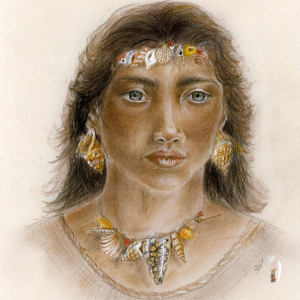Pendants and beads reveal nine cultures living across the continent 30,000 years ago

An artistic rendering depicts the bling preferred by Iberian foragers some 30,000 years ago.Sylvaine Jacquinot
Your jewelry may be sending all kinds of messages: You’re married or a Super Bowl champion. You worship Jesus or belong to the pearls and suits set—or perhaps the piercings and purple hair crowd.
For ice age hunters in Europe some 30,000 years ago, styles of ornaments including amber pendants, ivory bangles, and fox tooth beads may have also signaled membership in a particular culture, researchers report today in Nature Human Behaviour. The study, which compared thousands of handcrafted beads and adornments from dozens of widespread sites, suggests at least nine distinct cultures existed across Europe at this time.
“It’s a landmark paper,” says archaeologist Peter Jordan, a professor at Lund University and Hokkaido University who was not involved with the study. For centuries, archaeologists have tried to distinguish ancient peoples based on similarities in their artifacts. In recent years, however, sorting populations by ancient genetic group has at times overshadowed the archaeology. Here, “The archaeology strikes back,” Jordan says. “[It’s] showing that we can generate new narratives that also use a very rigorous, quantitative approach to the study of material traditions.”
The earliest known ornamental beads—seashells punched for stringing—come from early Homo sapiens sites dated to between 150,000 to 70,000 years ago in Africa and the eastern Mediterranean coast. Unlike knives or awls, ornaments offer no obvious survival functions. Instead, anthropologists think they likely communicated one’s traits and achievements, such as reaching adulthood, hunts completed, or family lines. “It’s a kind of common language or common discourse with other individuals in that group,” Jordan says. Many scholars think the invention of beads indicates that our ancestors had also evolved the capacity for symbolism and language.
Between 34,000 and 24,000 years ago, foragers in Europe fashioned beads from a diverse array of materials including ivory, bone, human and animal teeth, and flashy stones. These communities also painted caves and crafted so-called Venus figurines resembling voluptuous women, while coping with the glaciers and frigid temperatures of the last ice age. Despite the “horrendous” conditions, their artistic expressions suggest these people “weren’t just surviving—they were thriving,” says University of Bordeaux archaeologist and doctoral student Jack Baker.
Because of the widespread locations of figurines and similarly fashioned spearpoints, archaeologists traditionally clumped all these people into a single culture known as the Gravettian, spread from what is now Portugal to Russia. More recently, though, analyses of subtle differences in stone toolmaking, funerary practices, and ancient DNA have suggested more than one group roamed the continent at this time. Could the diverse beads found from this period result from different cultures?
As part of his dissertation, Baker aimed to find out. In 2020, he began to comb the literature for every ornament reported from 112 Gravettian burial and habitation sites excavated between the mid-1800s to 2010s. He classified thousands of beads into 134 types based on their raw materials and other design elements.
Next, he compared bead types between sites and found that places with similar accoutrements clustered geographically. Nine distinct groups emerged. People at the easternmost sites, such as Kostenki along the Don River in Russia, seemed to prefer ornaments made of stone and red deer canines, whereas those in northwest Europe wore tube-shaped shells of Dentalium mollusks.

Different ice age peoples formed personal ornaments from a variety of shell species.Jack Baker et al.
The Gravettian was not “one monolithic thing,” Baker says, but instead included several culturally distinct groups, each hewing to their own ornamental traditions. His team thinks these groups crossed paths: The team’s computer simulations suggest the patterns of bead differences most resemble a scenario in which neighboring groups occasionally swapped styles or territories. Perhaps ivory-adorned people gazed across a river and spotted a band decked in vibrant seashells: “They would have been like, ‘Oh my God! Someone completely different!’” Baker imagines. Despite those differences, some cultural and genetic exchange seems to have occurred.
DNA from human remains excavated from Gravettian sites identified two major genetic lineages in Europe at the time: one situated around the Pyrenees Mountains, and another in central and Eastern Europe. The bead-based groups mostly accorded with these populations, but added more subdivisions and a few twists, including data for places that have yet to yield ancient DNA, such as Moldova and southern Spain.
For groups for which genetic data are available, being closely related didn’t necessarily mean they wore matching jewelry. Ancient groups living in modern-day Italy, for example, shared ancestry but some buried their dead with cowrie shells and others put fish vertebrae and ivory beads into graves. In contrast, in what’s now France and Belgium, individuals with different ancestry sported similar ornaments. These results imply somewhat porous, shifting cultural boundaries, and perhaps some adornment differences for people with special social roles.
It makes sense that some peoples with shared ancestry may develop different cultural identities, reflected by their fashions and other behaviors—and conversely, that distinct genetic groups can blend culturally, says Cosimo Posth, a paleogeneticist at the University of Tübingen who was not involved with the new study. “It’s expected that genes don’t always match the culture that you’re carrying.”
Bioarchaeologist Elizabeth Sawchuk of the Cleveland Museum of Natural History adds that the database of Gravettian beads is “an enormous contribution to the literature.” She also praised the study’s synthesis of archaeological and genetic results. “We’re in a cool, new, interdisciplinary space and these are exactly the kind of studies that I would hope to start coming out,” she says.
